|
Home
Alphabetical list of all titles
The Tschiffely Collection
The Hanbury-Tenison Collection
The Cunninghame Graham Collection
Wanderreiter Klassiker
The Isabella Bird Collection
General
Africa
Asia
Australia and the Pacific
Europe
The Indian Subcontinent
Latin America
North Africa and the
Middle East
North America
The
Orient
Antarctica
Horse Packing and Travel
Our Publishing Mission
Equestrian Travel books by other
publishers

Visit The Long Riders' Guild - the world's first international
association of equestrian explorers!

Visit The Long Riders' Guild
Academic Foundation - "Science, not Superstition."

Visit Classic Travel Books for more exciting travel tales!
Website designed by Basha
O'Reilly
| |
North America
|

ISBN 1590480287
|
California
Coast Trails, J. Smeaton Chase - Few
books deserve the endorsement “forgotten gem.” Yet “California Coast
Trails” is entitled to that accolade and more!
An English immigrant, Smeaton Chase (1864-1923) came to California in 1890
where he pursued a career as one of the state’s earliest social workers.
Yet he never allowed his career to interfere with the life-long pursuit of
his twin passions, equestrian travel and botany.
Though Chase made many various horse trips throughout the American West,
this book describes his most famous journey, from Mexico to Oregon along
the coast of California. The amateur scientist doesn’t merely ride
along, he treats us to a treasure trove of observations, commenting on
subjects as diverse as the architecture of the Spanish Missions, the
hospitality of the people, and the beauties of a fabled countryside in the
last days of its pristine natural glory.
While Chase regales the reader with adventures, such as rescuing his horse
from quicksand, the book is far more than a mere account of an equestrian
exploration. It remains one of the most poetic and moving accounts ever
written by a man in the saddle. “California Coast Trails” is thus not
merely a “classic.” It is a blessing to any library and to every
reader.
Go
to Amazon.co.uk
or
Barnes & Noble for more details |
|

ISBN 1590481453
|
California Desert Trails, J. Smeaton Chase
- Imagine all the soft
places of the world, the green valleys, the soft beaches, the tranquil
islands, the cool mountains.
Now imagine you are on horseback in one of
the harshest deserts in the world – riding alone for two years! That is what famed British naturalist J.
Smeaton Chase did.
He mounted up and rode into the Mojave
Desert to undertake the longest equestrian study of its kind in modern
history.
Chase was no newcomer to equestrian travel. In 1910 he rode from the Mexican border to
Oregon, then penned a delightful book called ‘California Coast Trails,’
which recorded his impressions of the pristine beauty observed during that
ocean-front ride.
Then in 1916 the amateur naturalist headed
his horse inland in search of the secrets of a sun-drenched landscape few
had explored.
The resulting book, “California Desert
Trails,” is one man’s love affair with the Mojave Desert.
For Chase possessed the rare talent of
seeing beauty where others perceived only serpents and sand. He found wisdom
in unconventional places, with crazy hermits, wise Indians, and fellow
wanderers adrift in the desert. Traveling slowly as he did on horseback,
Chase was also able to observe the animals and plants that inhabited this
dangerous, but delightful, world.
The result is a book unlike any other in the
history of equestrian travel.
Amply illustrated with stunning black and
white photographs which Chase took during his long ride, this poetic travel
tale concludes with a special appendix, wherein Chase gives “Hints on Desert
Traveling” to a new generation of Long Riders and desert travelers.
Learn more at
Barnes & Noble
or Amazon.co.uk |
|

ISBN 1590480260
|
Following
the Frontier, Roger Pocock - Roger
Pocock was an Englishman whose tales of wanderlust and equestrian
adventure were nineteenth century travel classics. “Following the
Frontier” is considered his best work describing as it does his early
adventures in North America.
Although the autobiographical account reads like fiction, it is in fact
only the first half of his remarkable life. Pocock begins his tale by
explaining how he came to join the Canadian Mounties in 1885. When the
Saskatchewan Rebellion broke out soon afterwards, Pocock’s unit was
ordered to march from Regina to Fort Albert during the height of the
Canadian winter. The author’s feet were severely frost-bitten, leaving
him crippled for life.
Never one to be put off by physical adversity, Pocock went on to become
one of the nineteenth century's most influential equestrian travelers. One
of the highlights of “Following the Frontier” is the detailed account
of Pocock’s horse ride along the infamous Outlaw Trail, a 3,000 mile
solo journey that took the adventurer from Canada to Mexico City. During
this trip Pocock not only visited Robber’s Roost and Hole in the Wall,
he also spent many a night with the hunted American outlaws then
inhabiting this lawless section of the Old American West.
Although considered one of the finest writers of the nineteenth century,
Pocock’s story is more than just a literary adventure. It takes the
reader into backwoods, along forbidden paths, and into the den of danger!
Go
to Amazon.co.uk
or
Barnes & Noble.To read Pocock's fascinating book, Horses, please
click here.
|
|
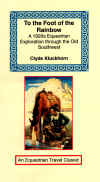
ISBN 1590480937 |
To
the Foot of the Rainbow, Clyde Kluckhohn -
He had a chance, a rare chance, to leave behind the smoky,
crowded streets of New England and journey out to the still unspoiled
American West. He had a chance, a rare chance, to forget that he was born
to ride a desk, not a New Mexican bronco. He had a chance, a rare chance,
to turn his back on convention and schedules, wrist-watches and bills,
misspent romance and a thousand other heart-aches.
He opted instead to climb up on the back of a untried horse and
ride off in search of equestrian adventure.
He had that chance, and he took it!
His name sounds ungainly today. “Clyde Kluckhohn”. Yet he was no
cartoon character. This was a young man in search of adventure and a
dream, to ride through the stony wastes of Arizona, Utah and New Mexico in
search of a geographic legend, “The Rainbow Bridge.” Native American
myth stated that somewhere in the rocky wastelands of Navajo-land stood a
gigantic, unbelievable arch of pure red stone. No white man had ever seen
it. No white man had ever ridden near it. Young Clyde Kluckhohn, the
Yankee horseman, determined to do just that!
Thus “To the Foot of the Rainbow” is not just a exciting true tale of
equestrian adventure. It is a moving account of a young man’s search for
physical perfection in a desert world still untouched by the recently-born
twentieth century. Amply illustrated with period photos, it remains a
classic tale of a daring man, his trusty horse, and their brave struggle
to discover a legend.
Go
to Amazon.co.uk
or
Barnes & Noble
|
|
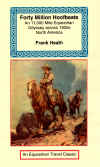
ISBN 1590480724
|
Forty
Million Hoof Beats, Frank Heath - Everyone
harbors a dream. Perhaps it is to leave the bills behind, see what is over
the next hill, or even seek for adventure. Frank Heath, the author of
“Forty Million Hoof Beats” did all that and more.
A former cavalryman during the First World War, Heath not only knew about
horses, but more importantly he understood the rigors involved in
undertaking a great equestrian journey. That is why he took a deep breath
before announcing to the world that he was going to ride to all 48 states
within the continental United States.
Most people would spend vast amounts of time and money to acquire a horse
for such a stupendous undertaking. Heath did neither. He traded a horse he
had on hand for a ten-year-old mare named Gypsy Queen. According to the
horse trader, the mare Heath acquired was a Kentucky Morgan. Yet fancy
pedigree aside, the little bay mare could cover ground like a fast moving
windstorm.
Mounted on Gypsy Queen, Heath set out in 1925 to see his vast country. The
journey lasted more than two years, during which time the two travelers
shared a long series of hardships, becoming inseparable companions in the
process. In 1927, more than 11,000 miles later, Frank and his Gypsy Queen
mare finally rode into Washington DC. The unlikely horse and her
cavalryman rider had touched every state in the Union. One man’s dream
had been achieved.
Long considered a classic equestrian travel tale, “Forty Million Hoof Beats”
influenced three generations of Americans to follow Gypsy Queen and Frank
Heath onto the high road of adventure. This marks the first time in more
than 50 years that this once famous book will once again be available to
the public.
Go
to Amazon.co.uk
or Barnes & Noble
|
|

ISBN 1590480333
|
A
Lady's Ride in the Rockies, Isabella Bird - The
American West of the late nineteenth century had seen its share of foreign
travelers but none could compare to Isabella Bird, the archetypal
Victorian Lady Traveler. The daughter of an English clergyman, Bird was on
her way back from Hawaii, which she had spent nearly a year exploring on
horseback, when she decided to stop off to investigate the Wild West.
Having suffered from ill health as a child, Bird therefore threw herself
into a life of open air and exercise as a means of recovery. “A Lady’s
Life in the Rocky Mountains” is told through letters the intrepid author
wrote to her sister in the winter of 1873 regarding this equestrian
sojourn during which she explored the magnificent unspoiled wilderness of
Colorado, ascended the highest mountains, observed the abundant wildlife,
and observed life on the remote frontier in all its phases.
Bird’s quest for equestrian adventure was to turn her into a compulsive
traveler and eventually take her on other equestrian journeys to equally
inaccessible places including Persia, Tibet, Japan, Korea and Morocco.
Plus she was also the first woman ever to be elected a Fellow of the Royal
Geographical Society of England.
Yet this remains the most popular book the prolific author, and
indefatigable traveler, ever penned. Enormously entertaining and amply
illustrated, “A Lady’s Life in the Rocky Mountains” remains a vivid
account of an astounding equestrian journey.
Go
to Amazon.co.uk
or
Barnes & Noble |
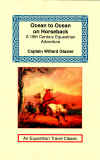 |
Ocean
to Ocean on Horseback, Willard Glazier - The
“soldier-author” was how Willard Glazier billed himself.
A penniless schoolboy at the beginning of the American Civil War, Glazier
enlisted in a cavalry unit of the Union Army of the Potomac and was soon
captured by Confederate troops. After a daring escape, he was recaptured,
only to escape a second time, before finally reaching the Union lines
again.
At the conclusion of the conflict Glazier wrote a book describing his
wartime experiences. When every New York publisher rejected him, the young
cavalryman self-published his work, hoping to make back his costs plus a
hundred dollars profit. Instead, to his delight, the book took off like
wildfire, selling 400,000 copies.
With the $75,000 profit realized from his efforts, Glazier determined to
ride “from Ocean to Ocean.” Leaving New York state in 1875 on his
horse, Paul Revere, the former trooper set out to see the mighty Pacific,
many miles and many unexpected adventures away.
“Ocean to Ocean on Horseback” is Glazier at his best, complete with
every sort of mounted adventure, and includes an account of how he was
kidnapped by Arapahoe Indians. Amply illustrated with pen and ink drawings
of the time, the book remains a timeless equestrian adventure classic.
Go
to Amazon.co.uk
or
Barnes & Noble |
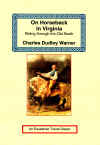 |
On
Horseback in Virginia, Charles Dudley Warner
- A
prolific author, and a great friend of Mark Twain, Charles Warner made a
witty and perceptive contribution to the world of nineteenth century
American literature when he and Twain co-authored “The Gilded Age”,
the book that gave the era its name.
In 1887 Warner
combined his urbane wit with a love of adventure travel when he penned
“On Horseback in Virginia.” Always a keen observer, the roving author
set out on horseback to investigate a great, rugged stretch of southern
Appalachia. The extended equestrian journey took Warner from Virginia,
through North Carolina, and into the remote hills of Tennessee.
Additionally, the book
contains a second narrative account of Warner’s equestrian adventures in
the Old West. This time he saddled up and rode from El Paso, Texas to
Mexico City, Mexico.
Both tales comprise a
book full of meaty descriptions told by one of America’s premier
nineteenth century storytellers.
Go
to Amazon.co.uk
or
Barnes & Noble
|
 |
Ride the
Wind, Miles Abernathy - Once they were famous from the Atlantic to
the Pacific.
If you had asked
any American school children in 1911 who Bud and Temple Abernathy were, they
would have given you a look of disbelief. “Everyone knows the Abernathy
Boys,” they would have said. And they would have been correct, because the
mounted adventures of the little Long Riders from Oklahoma Territory had
taken the United States by storm.
On their first
equestrian journey in 1909 the tiny travelers, aged nine and five,
encountered a host of Old West obstacles, including wolves and wild rivers,
when they rode more than 1,000 miles from Oklahoma to Sante Fe and back –
ALONE!
The following
year the intrepid brothers set their sights on New York City, which they
reached after a month of hard riding. Along the way Orville Wright offered
to take them up in his new-fangled airplane and President Taft gave them a
warm welcome when they reached the White House.
Kids envied them.
Women adored them. Grown men pulled hair from their horses’ tails to keep as
souvenirs. This public frenzy culminated when Bud and Temple rode their
Oklahoma ponies alongside Teddy Roosevelt and the Rough Riders in a victory
parade witnessed by more than a million cheering New Yorkers. Even though
they were only six and ten years old, Temple and Bud Abernathy were a
national sensation.
In the summer of
1911, they did the impossible. They rode nearly 4,000 miles, from New York
to San Francisco, in only sixty-two days. Once again, the Abernathy Boys had
made a historic ride without any adult assistance and accomplished an
equestrian feat which has never been equaled.
Now this
superbly-written version of their remarkable story, penned by a member of
their family in 1910, has been reissued in conjunction with the creation of
a life-sized statue being raised in honor of the world’s youngest equestrian
travelers.
“The Abernathy
Boys were mounted heroes whose memory deserves to be cherished by a new
generation of children and horse lovers,” said Basha O'Reilly, a Founder
Member of The Guild and Fellow of the Royal Geographical Society, who rode
from Russia to England.
This new edition
celebrates the equestrian legacy of Bud and Temple Abernathy.
Go to Amazon.co.uk or
Barnes & Noble. |
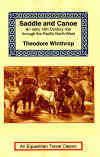 |
Saddle
and Canoe, Theodore Winthrop - At
first glance Theodore Winthrop didn’t look like a hardened equestrian
adventurer when he set out to travel across Washington Territory in the
early 1850s. The twenty-five-year-old was a recent graduate of Yale and a
confirmed East Coast intellectual. Winthrop didn’t let his education
handicap him however. Instead he set out to ride horses and canoes across
some of the most remote portions of the early United States.
The resultant
book, “Saddle and Canoe,” is a vibrant picture of frontier life in the
Pacific Northwest and covers the author’s travels along the Straits of
Juan De Fuca, on Vancouver Island, across the Naches Pass, and on to The
Dalles, in Oregon Territory. Throughout his journey Winthrop spent much of
his time among both pioneers and Indians, whose picturesque descriptions
are found within the pages of this historic travel account. Never one to
hold back his opinions, the Yankee traveler thus regales the reader with
personal observations and blunt honesty on a host of topics, people and
places.
Illustrated with
drawings of the period, “Saddle and Canoe” also contains a vocabulary
of the Chinook Indian language which Winthrop used during the course of
this historic journey. A treasure to read, the book will be of interest to
students of both the horse and history.
Go
to Amazon.co.uk
or
Barnes & Noble |
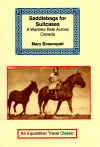 |
Saddlebags
for Suitcases, Mary Bosanquet - The year
1939 was a bleak and gloomy time in England. Fire and darkness loomed on
the horizon as war with Nazi Germany drew ever closer. In the midst of
this national angst young Mary Bosanquet had a revelation. She would toss
off college in London, board a steam-ship, voyage to Vancouver, Canada,
then buy and ride a horse alone more than 2,500 miles
to New York city. Simple enough!
She could ride, had a grand total of eighty English pounds to fund the
one-woman expedition, and figured horses would be cheap out in the Wild
West of Canada. Besides, she reasoned, if the world really was going to
self-destruct, she wanted a memorable adventure, “such as befell heroic
voyagers”, before the global ship sank.
If it was adventure the young English adventuress wanted, she got it!
Bosanquet rode through the mighty Rockies, was wooed by love-struck
cowboys, chased by a grizzly bear, feasted with lonely trappers, was
adopted for the winter by a family of Irish farmers, and even suspected of
being a Nazi spy, scouting out Canada in preparation for a German
invasion. And through it all she had Jonty and Timothy, her whimsical and
charming horses.
If the three inseparable companions sought to put the news of Europe’s
descent into the madness behind them, then their eighteen month journey
through the silent mountains, dreamy forests, and mighty plains of
pristine Canada provided the sanctuary they sought.
Illustrated with photographs taken during her remarkable trip,
Bosanquet’s story is as heart-warming today as the day it was written.
Go
to Amazon.co.uk
or
Barnes & Noble
|
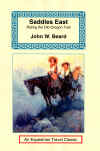 |
Saddles
East, John Beard - A
great many equestrian travelers could say they were inspired to take to
the saddle because of the exploits of someone who rode before them.
However John Beard is the only horseback traveler whose journey can be
directly linked to the influence of the famous Buffalo Bill Cody. Beard
determined as a child that he wanted to see the Wild West from the back of
a horse after a visit to Cody’s legendary Wild West show.
Yet it was to be more than sixty years after seeing the flamboyant
American showman before Beard, and his wife Lulu, finally mounted their
dreams. Setting off on a matched pair of horses, Black Diamond and Black
Fairy, the Beards left to discover the long cherished equestrian quest of
the author’s youth.
Their mission in 1948 was to ride the length of the Old Oregon Trail. What
followed was a 2,500 mile odyssey from Oregon to Missouri through a vast
sea of weariness, thirst, hunger, hardship, and danger as the aged
equestrians rode down the trail of their pioneer forefathers.
Amply illustrated with photographs, “Saddles East” is more than a mere
tale of adventure, it is the romantic story of two pilgrims of the sunrise
riding back into the morning of their youth, hunting for America’s
yesterday with everything they own on the backs of their faithful horses.
Go
to Amazon.co.uk
or
Barnes & Noble |
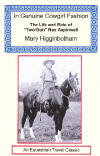 |
In Genuine Cowgirl
Fashion, Mary Higginbotham - The Long Riders' Guild is proud to announce the
publication of In Genuine Cowgirl Fashion, the life story
of Two Gun Nan Aspinwall, the first woman to ride across the United States
alone. Riding from San Francisco to New York City in 1910-11, Nan covered
4,496 miles during 180 days in the saddle.
Please go to Barnes & Noble
or Amazon.co.uk.
|

|
Two Thousand Miles on Horseback: Kansas to Santa Fé
in 1866,
James F. Meline -
The Old West was populated by a host of colourful characters including gunfighters, cowboys, buffalo hunters, sod
busters, and at least one cavalry officer with the eye of an eagle and a
penchant for fine writing. Colonel James Meline was an educated New York
journalist, turned pony soldier, who had fought for the Union during the
recent Civil War. With the country lulled into an uncomfortable peace, the
fifty-four year old Meline decided to partake of one last mounted adventure
before he hung up his spurs.
Lucky for the history of equestrian travel that he did.
The resultant book, “Two Thousand Miles on
Horseback” is a beautifully written, eye witness account of a United States
that is no more.
Meline was no fool. He sensed that the great
American wilderness was about to be tamed. Setting out from Fort Leavenworth
in the summer of 1866, Meline observed a nation on the move. In his first
week in the saddle Meline counted 680 wagons heading west. Moreover, he
warned, “the iron rail will soon clamp East and West, leaving no room for
adventure or personal freedom.”
Yet before that dire prediction became a
reality, Meline participated in one of the greatest equestrian adventures of
the time.
He noted everything from the price of
pistols to the practices of Pawnees. Border land barbarities too hideous “to
write in English,” horses struck dead by lightning, forlorn graves, summer
days so hot they drove men mad – Meline faithfully recorded the details of
prairie life seen during his ride to Santa Fe.
Once he reached fabled New Mexico the
saddle-borne scribe fell in with Kit Carson. What followed was a three day
marathon interview wherein the legendary frontiersman regaled the cavalry
journalist with tales of fighting the Navajo, hunting gigantic grizzly
bears, and eluding capture by Indians.
Then, with his notebooks full, Meline headed
home, experiencing a storm on the way that was so cold that “even my memory
froze.”
Though the frontier they inhabited is a
thing of the past, Meline and his cast of mounted characters still jump off
the pages and dare you to ride down the road of adventure with them. Go to
Barnes & Noble or
Amazon.co.uk. |
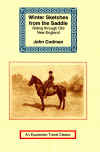 |
Winter
Sketches from the Saddle, John Codman,
with a Foreword by Brandon Schrand! -
The
author, a sea captain by trade, spent his leisure hours on land riding his
mare, Fanny.
A self-confessed "septuagenarian,” Codman was never shy about
sharing his horse-based opinions.
Walking, Codman said, was a “solitary entertainment” and the bicycle
he dismissed as being “unnatural.” Thus it was from the back of his
horse that the old sea captain sailed over the land of his birth.
This once-famous book, “Winter Sketches from the Saddle”, was first
published in 1888. It recommends riding for your health and describes
Codman’s many equestrian journeys through New England during the winter
of 1887.
“There is no greater pleasure than to find myself on a horse,” Codman
wrote.
The next best thing is to read his classic book!
Go
to Amazon.co.uk
or
Barnes & Noble
|
Home |